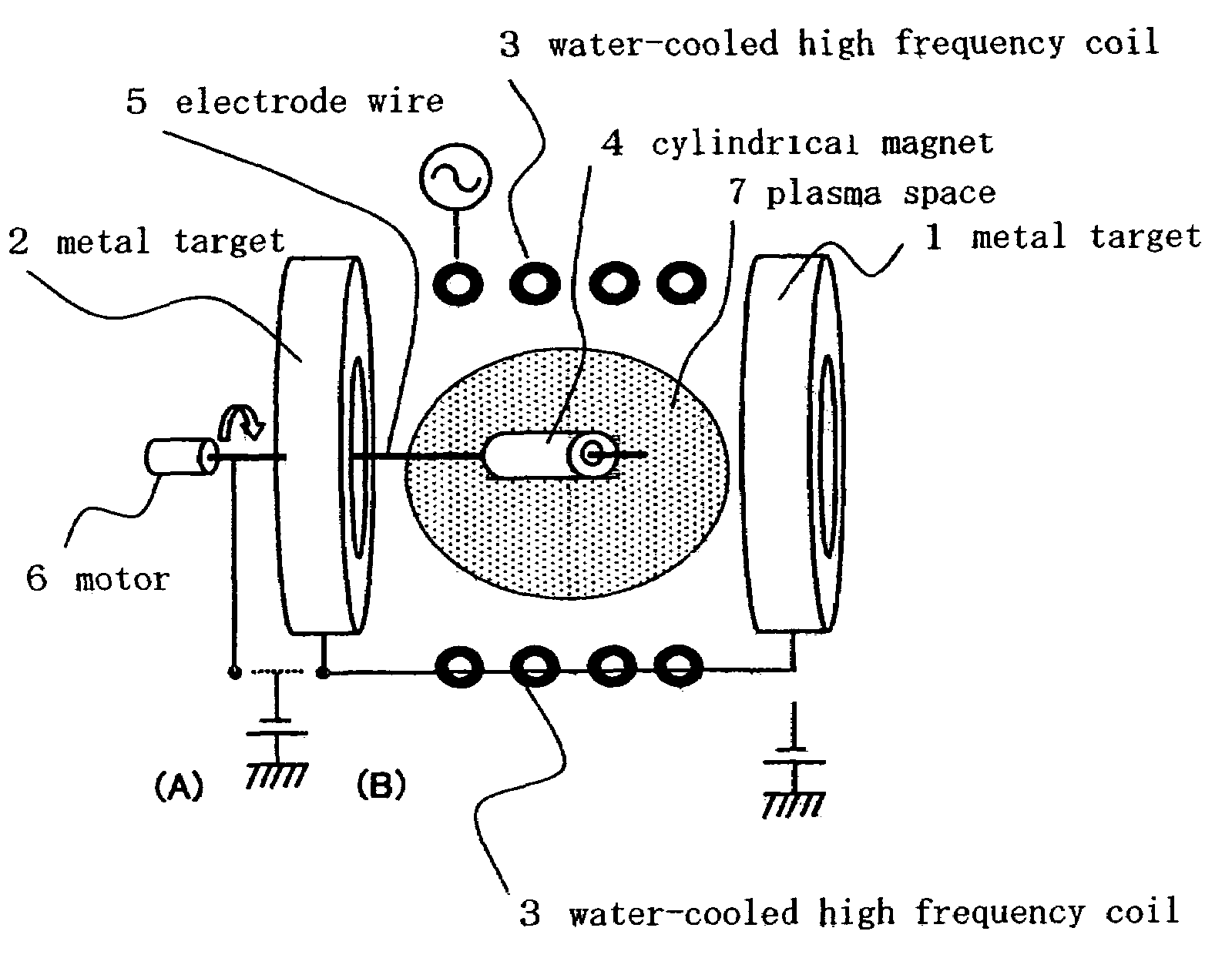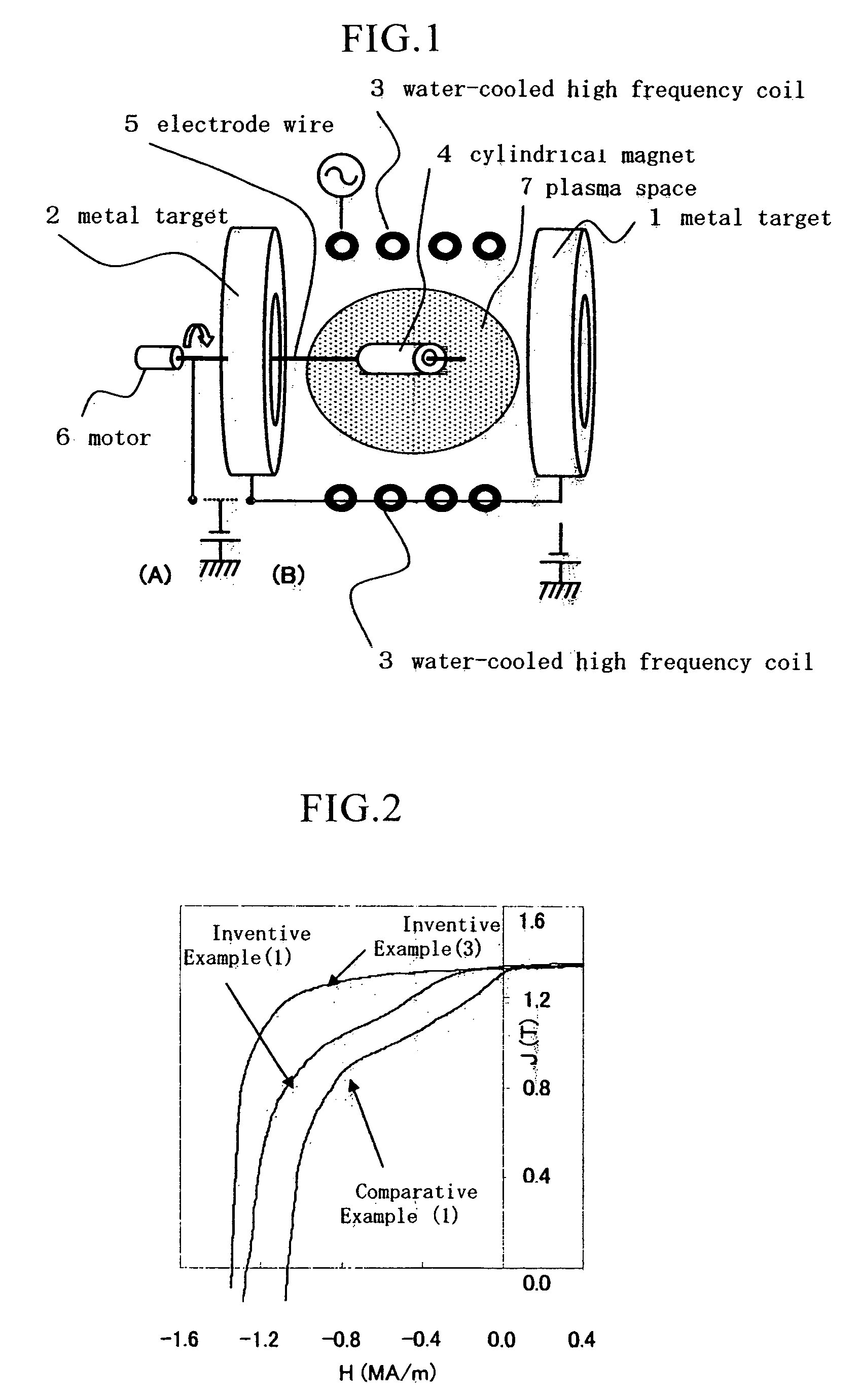Minute high-performance rare earth magnet for micromini product and process for producing the same
a rare earth permanent magnet, micro-mini technology, applied in the direction of superimposed coating process, liquid/solution decomposition chemical coating, magnetic body, etc., can solve the problems of difficult to recover magnetic properties, long time-consuming and laborious, solution remains in the pores of sintered magnets, etc., to achieve small and high output power motor, small and high performance magnets, and sufficient restoration of magnetic properties
- Summary
- Abstract
- Description
- Claims
- Application Information
AI Technical Summary
Benefits of technology
Problems solved by technology
Method used
Image
Examples
embodiment 1
[0055]From an alloy ingot having a composition of Nd12.5Fe78.5Co1B8, alloy foil having a thickness of from 0.2 to 0.3 mm was prepared according to the strip casting method. Next, the foil was packed in a vessel and allowed to absorb hydrogen gas at 500 kPa and at room temperature and the gas was released, thereby obtaining un even powder having a general size from 0.15 to 0.2 mm. Then, the uneven powder was subjected to jet mill pulverization, and thereby fine powder of approximately 3 μm particle size was prepared.
[0056]The fine powder was admixed with 0.05% by weight of calcium stearate, press-molded in a magnetic field, charged into a vacuum furnace and sintered at 1080 degree centigrade for 1 hr, and thereby a cubic magnet block material with sides of length 18 mm was obtained.
[0057]Subsequently, to the cubic magnet block material, grind stone cutting, outer periphery grinding and ultrasonic drilling were applied and thereby a cylindrical magnet having an outer diameter of 1 mm,...
embodiment 2
[0066]On the cylindrical magnets that were manufactured in embodiment 1 and have an outer diameter of 1 mm, an inner diameter of 0.3 mm and a length of 3 mm, metals of Nd, Dy, Pr, Tb and Al each were deposited, respectively. Here, target dimensions of Nd and Al were 80 mm in the outer diameter, 30 mm in the inner diameter and 20 mm in the thickness, the same as that of Dy in embodiment 1; on the other hand, Pr and Tb targets were prepared by applying and fixing the respective metals with a thickness of 2 mm on the surfaces that faced to the magnet of the Al target.
[0067]After the Nd metal target was attached to the three-dimensional sputtering apparatus, two of the cylindrical magnets were attached to a tungsten electrode wire followed by depositing the Nd metal. Similarly, other metals were deposited on the surface of the magnets. In the deposition, into the apparatus, Ar gas was introduced to maintain a pressure inside of the apparatus at 3 Pa, RF output power of 20 W and DC outpu...
embodiment 3
[0071]A sintered magnet block having a composition of Nd12Dy2.5Fe76.5Co1B8 was cut, ground and drilled, and thereby a disc-like magnet having an outer diameter of 10 mm, an inner diameter of 3 mm and a length of 1.4 mm was prepared. Volume is 100 mm3, surface area is 200 mm2, and surface area to volume ratio is 2.0 mm−1. On both surfaces thereof, a Tb film was deposited. The sputtering conditions were as follows. That is, by applying RF output of 40 W and DC output of 2 W, the reverse sputtering was performed for 10 min; thereafter by applying RF output of 150 W and by varying DC output from 100 to 800 W, magnets different in sputtering conditions were prepared.
[0072]The relationship between the DC output and the film thickness of the deposited Tb film was investigated. Based on the result of investigation, in order to obtain a thickness of a deposited Tb film of substantially 3 μm for all magnets, the sputtering time was set to be 20 min for 100 W and to be 5 min for 800 W. Further...
PUM
| Property | Measurement | Unit |
|---|---|---|
| Pressure | aaaaa | aaaaa |
| Fraction | aaaaa | aaaaa |
| Concentration | aaaaa | aaaaa |
Abstract
Description
Claims
Application Information
 Login to View More
Login to View More - R&D
- Intellectual Property
- Life Sciences
- Materials
- Tech Scout
- Unparalleled Data Quality
- Higher Quality Content
- 60% Fewer Hallucinations
Browse by: Latest US Patents, China's latest patents, Technical Efficacy Thesaurus, Application Domain, Technology Topic, Popular Technical Reports.
© 2025 PatSnap. All rights reserved.Legal|Privacy policy|Modern Slavery Act Transparency Statement|Sitemap|About US| Contact US: help@patsnap.com



